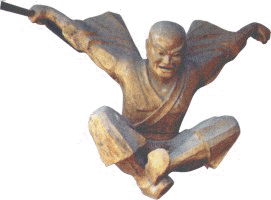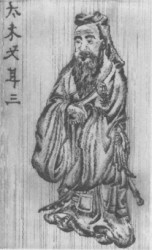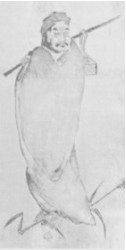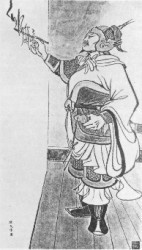|
FE.I.K. FEderazione
Italiana Kung-fu
V.le Certosa n°181, c.a.p.
20151 - Milano. Tel e Fax: 02-38000801
http://wwwfiek.it - E-MAIL.
info@feik.it
|
|
home page |
|

THE MILENARY ART
The practice of the war was born when a man
desired something tha another man desired too; sinche then, it
never left os. If we consider that fire weapons are a recent
resource, especially in the East, we can't deny that the martial
art was born with the man. However, storycal proofs about the
existence of a real combat discipline are more recent, and for
what concern China, can hardly be distinguished by legend. In
fact, the documentation that came to us is too insufficient and
unreliable, that's why in our opinion, the historycal tractation
is necessarily uncertain.
Just in early historycal age, at the time of
the mythical Yellow Emperor Huang Ti (2697 a.C.), legends says
about the existence of a violent fighting technique, the "ch'ih
yu hsi", in which the opponents try to pierce one with the other
using a hat with horns on it; Huang ti himself defeated this way
the evil horny monster Ch'ih Yu, allegorical figure chat could
represent a cruel military commander of the times.
More probably it was a head blows-based
fight, named "Go ti", survived under ritual form until recent
times.
Archaeological founds in the shape of
bathtubs frescoed with scenes of nude hands combat are dated
1700 a.C.
With the advent of Chou dinasty (XI-III sec.
a.C.), appear the first historycal proofs about martial arts: in
the "Book of the rituals", for instance, can be found many
descriptions of disputes based on boxe, catch, fencing and bows.
The term used these times to indicate bare hands martial arts
was "chi chi", "beating with skill", a less important military
branch, if compared to the use of the bow or the war carts.
This was a period of great cultural fervor,
with the presence of saviors that will influence forever the
chinese way of thinking. Among others we can name Kung Fu Tzu,
taoist Lao Tzu and the great strategists Sun Tzu and Wu Tzu.
|
|
|
 |
|
KUNG FU TZU |
| |
At the same time in which Confucio lived, there
was a savior (??),
Master Mo Ti. He founded a really interesting and
complex phylosophical system, he was also a great warrior, leader of
a group of knights who represented the acme of the martial abilities
in the whole chinese history.
It was the turbulet period of the "fighting
nations" (V-III sec.a.C.), and these valiant warriors, named "yu
hsie", "roaming knights", were requested,experts warriors, hired by
local lords.
The famous history expert Szu Ma
Chien (204 a.C.), tells us about yu hsie as individuals whith a deep
moral thickness, true courage and a strong determination.
When the armies in which they battled lost some fight, the roaming
knights often
took shelter in isolated villages, on high mountains or in silent
temples.
Here they could create, under their sage guide, martial schools and
warlike sects, giving their contribution to the mixture between
martial ability and the philosophical and esoteric research which
was part of their lives.
Taoist temples, where people
still practiced a doctrine full of local chinese animism, were a
perfect place to develop the broad philosophy on which kung fu
is based.
Arose in this way disciplines close to magical practices, with
misteryous names such as "Fa shu", the black art, "Yin shen shu",
the art of making the body invisible, or "Mou Shan shu", the art
of Mou mountains.
We must remember, however, that the masters who taught those
arts were experts in really ancient practices, of which they
were only the more recent exponents.
So we came, between revolts and peacefully times, to the grand
prosperity of Han dinasy (206 a.C - 220 a.C). In this period,
bare hands martial arts were named "chi ch'iao", skill and
talent, or "shou po", hand that hits the fist; instead, the Kuo
I's invention of "chang shou", the long hand was born during the
I sec a.C; this style could probably be a direct ancestor of the
Shaolin temple's boxing style.
When Han dinasty was laid down, began the "three reigns period"
(220-280 d.C), in which martial arts has been deeply refined,
and many heroes mourn their legends.
Just before this age, taoist doctor Hua To (141-208), codified
"The game of the five animals", a set of phisical and energetic
exercises based on five animals (according to some history
experts the animans cound have been ten): tiger, bear, deer,
monkey and crane. This is one of the first proofs of a phisical
pracice inspired by the animal kingdom, thing that became usual
between martial arts masters.
|
|
|
 |
|
BODHIDHARMA (TA MO) |
|
|
The next stop in the story of kung fu concerns the
most renowned event ever; the settling on chinese soil of the
indian priest Bodhidharma (Ta Mo in chinese), in the year 527
d.C., 28th patriarch of the Buddism, erroneously considered the
beginner of Shaolin kung fu.
Shaolin Szu (small forest's convent) arose on the slopes of one
of he holy mountains of China, the Sung Shan, in Honan
province; it was built in 496 d.C. by the emperor Wen Ti to
shelter the indian monk Pa Tuo, and probably had already
sheltered inside its walls some other monk, who was skillfull in
the art of fighting, or some expert warrior, attracted by the
recent rebirth of the buddist doctrine.
What probably Bodhidharma did, besides giving a strong turn to
chinese buddism with the consolidation of the Ch'an sect, was to
bring to Shaolin the yoga breathing techniques, to help monks to
better stand their very hard meditation meetings.
About this, two dissertations about anatomy and physiology are
imputed to Bodhidharma: the "I Chin Chi'ing" (dissertation on
tendon's movement) and "Hsi Sui Ching" (dissertation on the
washing of the marrow). it doesn't seem impossible, however that
Ta Mo knew some fighting technique, because he was son of a king
of one of the native lands of very ancient indian martia arts,
"Madras", in Kerala.
And more probably seems the fac that, in those ages, between
indian monks in China that taught buddism, and chinese monks in
India to study it, could have been some exchange of martial
knowledges.
However, a century later the mysterious passing of Ta Mo, the
fame of great Shaolin fighters becan to spread in the whole
Chinese territory.
The physical and mental training derived from the monastical
asceticism, probably began to yield to some results. At the same
time, and during all of the history of the convent, it was a
secure shelter for repented outlaws and converted or wanted
warriors. All skillfull warriors, who could compare themselves
with the monks' practices. So the Shaolin's knowledge continued
to grow, as its fame did, reaching the apex between 1500 and
1600.
Tales of that age say that wasn't simple to be admitted to
Shaolin Szu, and after admitted, the novice was subjected to
tests and humiliations that even the strongest couldn't stand,
all to feel the personality of the student. Then they shaved his
head, and on it, an older monk. during a special ceremony
applied some burnings with a particular vegetal paste. That was
the brand that indelibly sealed the choice of the monk.
Neither it wasn't simple to penetrate the convent, nor escaping
from it without the approbation of the superiors, because it was
full of deadly traps. The shaolin monk could leave the temple
only when the masters have had judged him ready to leave. At
that point, according to the legend, he had to pass the last,
terrible test: the 36 chambers.
This was a trail between the dungeon of the temple, that the
monk had to cover to reach the exit gates. There he would have
find an heavy cauldron full of burning coal, with a dragon and a
tiger inlaid on its sides; during the carrying of the cauldron,
those symbols would have fixed un the forearms of the monk, to
seal forever his belonging to the order. But in every of the 36
chambers there were deadly snares that the monk would have face
to show his bravery and his qualification.
According to a more realistic version, the monk had to face 36
fellow-members, and everyone of them have had to fight in
different modes, (SENZA ESCLUSIONE DI COLPI).
One of the first shaolin styles that can be remembered is the
"Sho Pa Luohan Shou", the eighteen hands of the disciples of
Buddha, whose name is also used to identify modern moves.
Were also famous the 32 techniques of "T'ai Tzu chang ch'uan",
"the long boxing of the Grand Ancestor", created by the emperor
Chao K'uang Yin (X sec.). The same dinasty was the one of the
famous general and chinese hero Yuei Fei, very skillfull in the
use of the spear ad creator of the "pa tuan chin", the eight
pieces of palisade, an energetic gumnastics that prepared the
body for the kung fu.
To commander Yuei Fei the legend also impute the creation of the
famuos inner style "hsing i".
But the style tha can be easily imputed to the convent is "wu
hsin ch'üan", the boxing of the five forms, inspired, as Hhao To
did, to the way of fighting of five animals: dragon, tiger,
leopard, snake and crane.
It was codified during the XVI cent. by monk Chuei Yuan, after
he took benefit of hints and midifications to the masters Li Sou
and Pai Yu Feng's Shaolin style.
The 70 techniques of the original "wu hsing" form are lost, and
the today homonymous forms were built in more recent times.
| |
|
 |
|
YUEH FEI |
| |
In the meantime other softer forms of Shaolin have been thought, as
the "rou ch'uan", soft boxing, and the "mien ch'üan", cotton fist,
ancestors of the inner styles; the truth is that, to see a real
division between inner and outer styles, we have to wait until Ch'ing
dinasty (1644-1911).
This is another crucial point of kung fu history: from 1644 to 1911,
China was ruled by Manchu, a northern rude barbaric peopling that
took possession of the imperial throne, laying down the last Ming
emperor.
Since the first times, between chinese people revolts and resistance
arose against the invader.
Fighting religious orders were on the first line of the battle, and
the convents became training centers and a shelter for the rebels.
This was noted by the invader army, that denied with capital
punishment the martial arts and the weapon's use, and in the 1736
destroyed for the second time the Shaolin convent.
The monks who survived the attack were scattered throughout the
chinese land.
They started to secretly train the population, wherever they were,
for the upcoming anti-manchu rebellion.
This led to a very large diffusion of the martial arts between the
population, for centuries reserved to accurately chosen individuals,
but also to the scattering of the masters over the very vast
territory, leading to a latterly fragmented knowledge and styles.
At the same time, without any doubt with the secret help of the
monks and the fighting clans, there was a revival of the secret
societies, born in opposition to the power of the rulers, and to
take care of the overwhelmed people.
They were the ancestors of the modern triads, successively
degenerated in criminal gangs. Thanks to the aforesaid scattering,
however, many of the northern styles could reach the southern
provinces.
There's a tale about this, widely spread in kung fu ambients, that
tells that the monks survived to the destruction of Shaolin temple
in 1736, found shelter in the south, in Fuchien region, where they
built a second temple (according with some history experts, the
Fuchsien's Shaolin temple already existed, as other omonymous
temples of the order), and created the southern Shaolin school (Siu
Lam), that had to influence the forming of some temple's styles. But
a few years later the Fuchien temple was destroyed too, and only 5
monks survived, and gave birth tho new Southern Shaolin styles. "Choi
li fat", "hung gar" and "mok gar" among the others.
It was exactly during the unlucky Ch'ing dinasty that many of the
modern styles emerge to the history's attention, as "t’ai chi ch'üan"
and "pa kua" for the inner school, "pai ho", "pai mei" and "yung
chun" for the southern school.
Ch'ing dinasty fell down because of a rebellion in 1911, and an year
later was proclaimed the republic.
Again martial arts were reborn, supported by the government's
enthusiasm, that founded in Nanching a big kung fu academy, named
Nanching Kuo Sho Kuan, where were called to teach some of the
greatest masters of those times.
Great amsters, whose name still shine in the annals of various
schools. But history was keeping a new storm for the chinese martial
arts: after the taking of the powers by the Mao Tse Tung's communist
army (1949 october, the 1st), the government tried to reorganize the
broad panorama of the local martial arts, purifying them by most of
the martial techniques and creating this way a simple physical
exercise, something like a gymnastics with a martial coreography,
characterizedby a big spectacular side, and from the other hand by a
better care about health and practical aspects.
This discipline, was named again "Wu Shu", in ruled today in Popular
China by the ministry of sports, and taught by physical education
teachers who rely on the ministry.
Really different if compared to the warrior wisdom of ancient kung
fu (or traditional wu chu).
The settling of the comunism in china and the consequent Cultural
Revolution represented a dark period for the chinese martial art's
history, because of the fierce persecutions against the traditional
masters, who became clandestines or emigrated abroad, if they didn't
accept hte new laws.
Only in recent times the situation is getting better, thanks to a
revaluation of the rich historical patrimony of the "Middle Reign".
In the meantime, the art reached the edonistic western shores.
The USA, thanks to previous bindings going back to the 1800, were
the privileged territory, and for what concerns the Eurome, french
people can claim to be the firsts to get close to eastern martial
arts.
Without excluding the contacts with european armies during military
campaigns.
We think primarily to the racist movements of "I Ho Ch'üan" (The
fists of justice and harmony), known by the western people as the
boxers revolt, because their leaders were kung fu practitioners.
These one, above all the ones from Shantung, followed an exoteric
form of "mei hua ch'üan" style, before the battle they made
autosuggestion with mystical practices, and they felt themselves
invincible againts the bullets of the western artillery.
The result, when they throw themselves to the steel weapon against
the riflemen's rows, wasn't surely the invincibility, but european
soldiers were astonished by the superhuman-like skills shown by
these men during the battle.
Recently hte aforementioned sport discipline of modern wu shu came
out of Popular China, supported with promotional emphasis by Beijing
govern, and well received everywhere (even if the first apparition
was during the Berlin Olympic games in 1936).
At first it was based on the single athlete choreographies or on
preordered fightings, with bare hands or with weapons, the
discipline was recently subsequently enriched by a division that
cares about sport free fighting, the "Sanda".
Wu shu codifided for the contests is also divided in northern styles
(chang ch'üan) and souther styles (nan ch'üan), with added some
reserved categories for the so-called imitation styles and inner
styles.
Even in the kung fu and in the traditional wu shu world today is
developed the sport practice, that in truth should be a nonsense,
and orthodox schools know about this. Also in this case we have form
contests, single or in pairs, with or without weapons, and free
fighting contests, but generally the attribution of the poits differ
from modern wu shu, as ideal intents of the two arts do.
|
|



